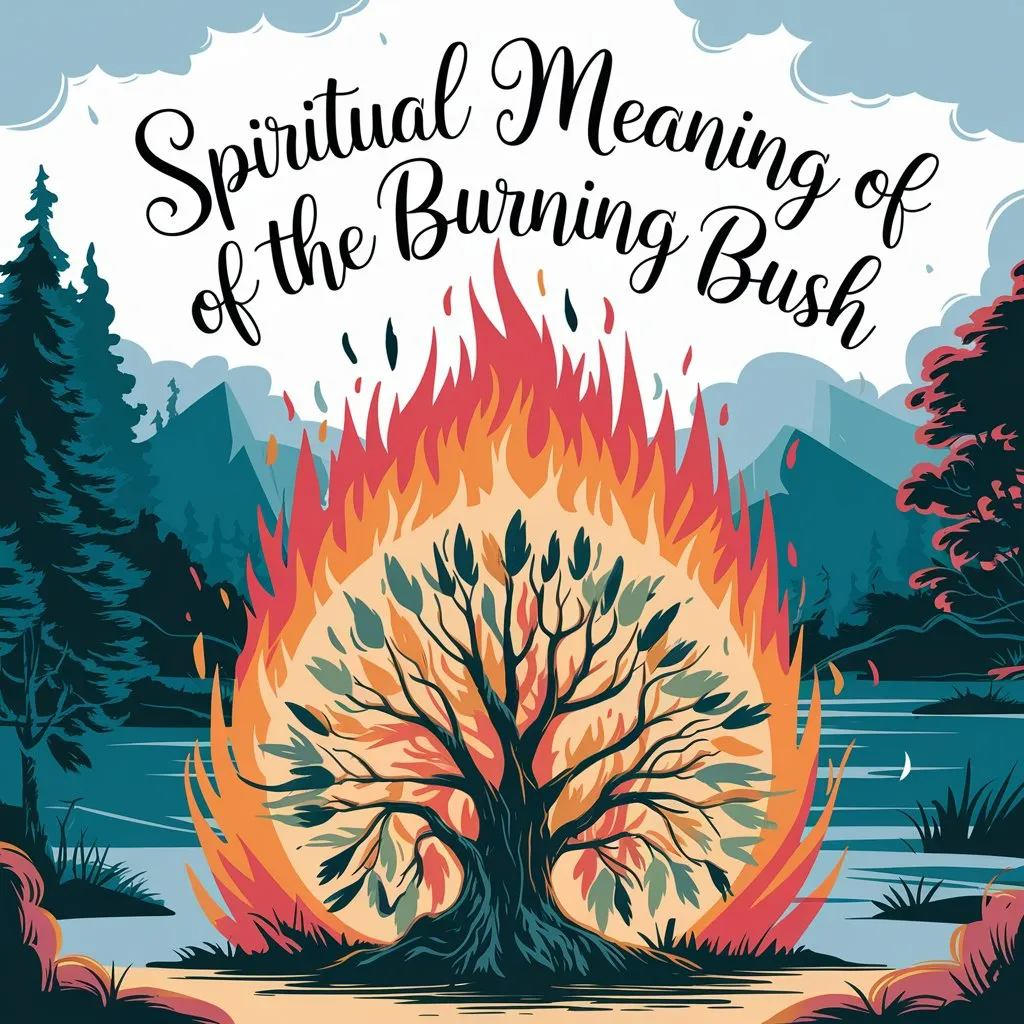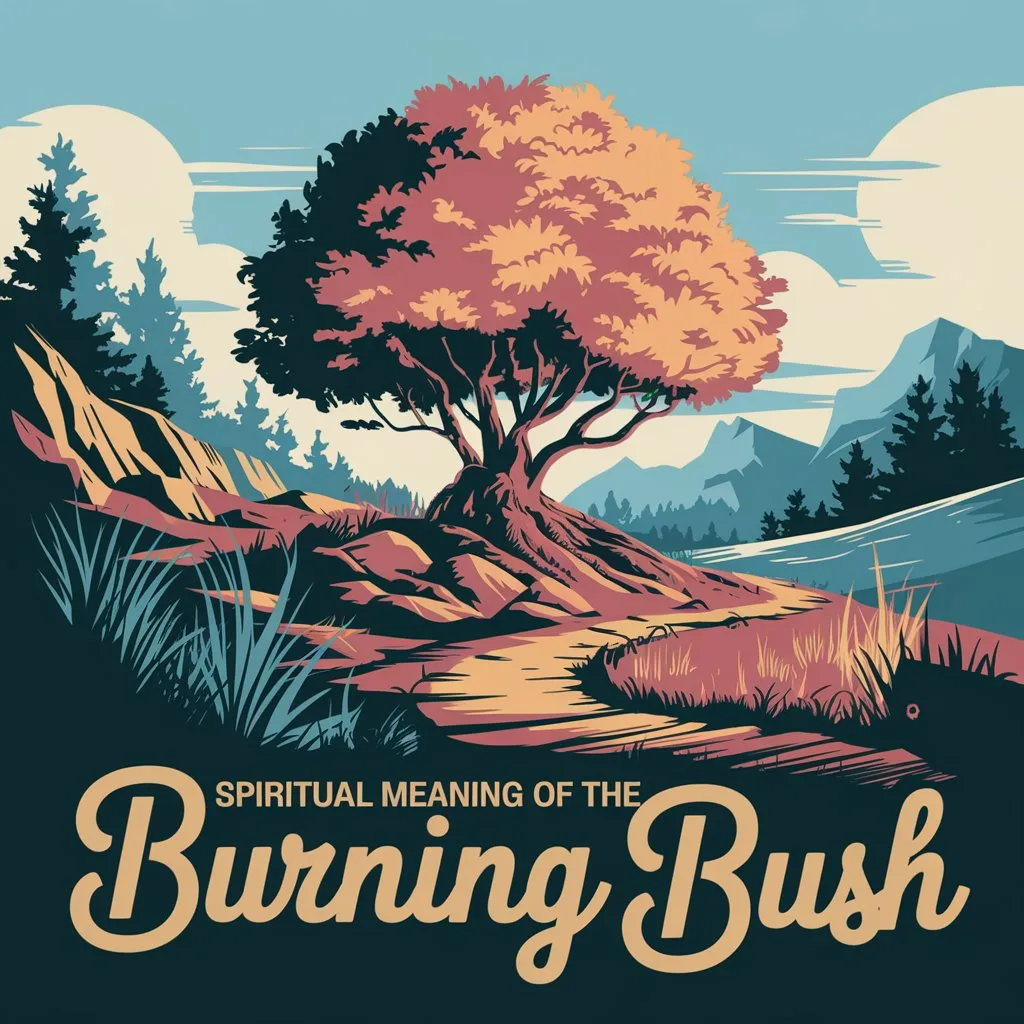The burning bush stands as a powerful symbol in spiritual traditions, captivating the minds and hearts of believers for centuries.
This extraordinary phenomenon, where a bush burns without being consumed, represents a profound encounter with the divine that transcends ordinary human experience.
As we delve into the depths of its spiritual meaning, we’ll uncover layers of symbolism that speak to the nature of God, human transformation, and the sacred journey of the soul.
Key Takeaways:

- The burning bush symbolizes divine presence and manifestation
- It represents spiritual transformation without loss of essence
- The phenomenon introduces the concept of sacred ground
- It marks the beginning of a divine calling or mission
- The bush symbolizes purification and refinement of the soul
- It reflects the possibility of mystical union with the divine
- The burning bush holds typological significance in various traditions
- It embodies the concept of eternal present in spiritual realms
- The symbol resonates with universal spiritual themes
Divine Presence and Manifestation
The burning bush primarily symbolizes the presence and manifestation of the divine. In the biblical account, it represents a theophany – a visible appearance of God to humans. This extraordinary phenomenon signifies that:
- God can reveal Himself in unexpected ways and places
- The divine presence can transform ordinary objects into sacred vessels
- Spiritual encounters often occur in seemingly mundane circumstances
The burning bush serves as a powerful reminder that the divine can manifest in our lives at any moment, often in ways we least expect.
It challenges us to remain open and attentive to the possibility of encountering the sacred in our everyday experiences.
This symbol encourages us to cultivate a sense of wonder and reverence for the world around us, recognizing that any place or object can become a vessel for divine revelation.

Unconsumed Nature
A key aspect of the burning bush is that it burned but was not consumed. This paradox carries deep spiritual symbolism:
- It represents the eternal nature of the divine – ever-present but never depleted
- Symbolizes spiritual transformation without destruction of one’s essence
- Reflects the idea of divine energy sustaining creation without consuming it
The unconsumed nature of the burning bush offers a profound metaphor for our spiritual journey. It suggests that we can be transformed by divine fire without losing our essential selves.
This concept invites us to embrace spiritual growth and transformation, assuring us that the process, while potentially intense, will not destroy our core identity but rather refine and elevate it.

Sacred Ground and Holiness
The burning bush episode introduces the concept of holy ground:
- It emphasizes the gap between the divine and human, requiring reverence
- Illustrates how God’s presence sanctifies a place, making it sacred
- Teaches the importance of approaching the divine with humility and respect
The idea of sacred ground challenges us to recognize the holiness that can permeate our surroundings. It reminds us that certain spaces and experiences deserve our utmost respect and reverence.
This concept encourages us to create and honor sacred spaces in our lives, whether through formal rituals or by simply acknowledging the divine presence in our daily environments.
Divine Calling and Mission
The burning bush serves as a medium for divine communication and calling:
- It marks the beginning of a spiritual journey or mission (for Moses, leading the Israelites)
- Represents God’s initiative in reaching out to humans for a higher purpose
- Symbolizes the transformative power of encountering the divine
The burning bush as a symbol of divine calling reminds us that we may be called to fulfill a greater purpose in our lives. It suggests that spiritual awakening often comes with responsibility and a mission.
This aspect of the symbol encourages us to listen for our own calling and to be open to the ways in which the divine might be guiding us towards our life’s purpose.

Purification and Refinement
Fire in spiritual contexts often symbolizes purification:
- The burning bush can represent the refining quality of God’s holiness
- It suggests spiritual awakening and enlightenment
- Symbolizes the burning away of impurities in one’s spiritual journey
The purifying aspect of the burning bush offers a powerful metaphor for personal growth and transformation. It reminds us that spiritual evolution often involves letting go of what no longer serves us.
This symbol encourages us to embrace the refining fire of spiritual practice, knowing that it can burn away our impurities and leave us more aligned with our highest selves.
Mystical Union
In some mystical interpretations, the burning bush represents:
- The union of divine and human natures without one consuming the other
- A symbol of mystical experiences where one encounters the divine directly
- The integration of spiritual fire into one’s being without being destroyed
The concept of mystical union as represented by the burning bush invites us to contemplate the possibility of a deep, personal connection with the divine.
It suggests that we can experience profound spiritual states without losing our individuality. This interpretation encourages us to seek out and value mystical experiences as part of our spiritual growth.

Typological Significance
In Christian tradition, the burning bush is seen as a type or prefiguration:
- It’s interpreted as a symbol of the Virgin Mary, who bore God incarnate without being consumed
- Represents the Church, indwelt by the Holy Spirit yet remaining intact
- Foreshadows Christ’s divine nature united with human nature
The typological interpretations of the burning bush demonstrate how spiritual symbols can evolve and take on new meanings across different traditions.
This aspect of the symbol reminds us of the rich interconnectedness of spiritual ideas and encourages us to explore the depths of symbolism in our own faith traditions.
Eternal Present
The “I AM” declaration associated with the burning bush conveys:
- God’s eternal nature, existing in an ever-present now
- The timelessness of spiritual truths
- The importance of being present in one’s spiritual life
The concept of eternal present embodied in the burning bush story challenges our linear understanding of time. It invites us to experience the divine in the here and now, reminding us that spiritual truths are timeless and ever-accessible.
This aspect of the symbol encourages us to cultivate mindfulness and presence in our spiritual practices.

Universal Spiritual Themes
While rooted in specific traditions, the burning bush symbolism resonates with universal spiritual concepts:
- The interconnectedness of the material and spiritual realms
- The potential for extraordinary experiences in ordinary settings
- The transformative power of spiritual awakening
The universal themes represented by the burning bush highlight the common ground shared by various spiritual traditions.
This aspect of the symbol encourages us to look beyond the boundaries of our own faith and recognize the shared wisdom in different spiritual paths. It reminds us that profound spiritual truths often transcend cultural and religious divisions.
FAQs
What is the spiritual significance of the burning bush?
The burning bush symbolizes divine presence, spiritual transformation, and sacred encounters. It represents God’s manifestation in the physical world, the eternal nature of the divine, and the potential for profound spiritual experiences in ordinary settings.
Why wasn’t the bush consumed by the fire?
The unconsumed nature of the bush symbolizes the eternal, inexhaustible nature of God. It also represents how divine presence can transform without destroying, and how spiritual experiences can refine us without consuming our essence.
How does the burning bush relate to the concept of sacred space?
The burning bush introduces the idea of holy ground, emphasizing that God’s presence can sanctify a place. It teaches the importance of approaching the divine with reverence and recognizing that any space can become sacred when touched by the divine.
What does the burning bush teach us about divine calling?
The burning bush story illustrates how God can call individuals to a higher purpose. It shows that divine encounters often come with a mission or responsibility, and that God can use unexpected means to communicate His will.
How is the burning bush interpreted in different spiritual traditions?
While primarily associated with the Abrahamic faiths, the burning bush has universal spiritual significance. In Christianity, it’s seen as a prefiguration of Mary and Christ. In mystical traditions, it symbolizes the union of divine and human natures. Across cultures, it represents spiritual awakening and transformation.

Hello, I’m Zephyra, your guide at SpiritualityEssence.com. I’m passionate about uncovering life’s mysteries and sharing transformative insights. Let’s explore mindfulness, ancient rituals, and the path to a more awakened life together. Join me on this spiritual journey!
















